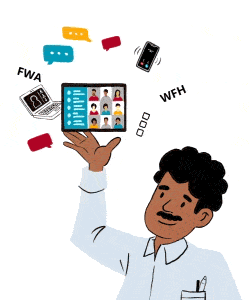Brought to you by

Have you heard about Flexible Work Arrangements (FWAs) — i.e. variations from the usual work arrangements? You may be familiar with working from home or telecommuting due to the coronavirus pandemic. How about job sharing and staggered time?
Whether it’s flexi-time, flexi-load or flexi-place, FWAs can help employees achieve work-life harmony and at the same time, give companies a competitive edge in attracting and retaining talent.
Take the quiz below to learn more about the different types of FWAs and how you can make flexible work a win-win for the organisation and yourself!

John's mother recently had a bad fall and fractured her hip. She needs to go for regular physiotherapy sessions at 8.30am, thrice a week. She needs John's help to take her to the appointments. However, as John starts work at 8.30am, he is unable to accompany his mother and make it to the office on time. What should he do?
- Quit his job
- Use his annual leave to accompany his mum for physiotherapy
- Discuss flexible work arrangements (FWAs) with his employer

Mrs Foo is the Chief HR Officer with XYZ hotel. She used to think that FWAs would benefit only employees but heard that implementing FWAs at the workplace can be a win-win situation for both employees and employers. Is this true?
- No, it benefits only the employees
- No, it benefits only the employers
- Yes, it benefits both employees and employers

Anika's eldest child, George, is taking the Primary School Leaving Examination (PSLE) this year and she wants to spend more time at home to give him emotional support. Her job as a medical lab technician does not allow her to work from home. She hopes to explore FWA options with her employer. What are some possibilities?
- Part-time work arrangement: Work reduced hours on a regular basis (e.g. Anika can reduce her working hours from 40 to 20 hours per week)
- Compressed Work Schedule: Work full-time hours in fewer than the normal number of days per time-period (e.g. Anika can opt to work 40 hours within a four-day work week and spend the rest of the week on her family needs)
- Job sharing: Have at least two persons to share the responsibilities of one full-time job (e.g. Anika can share her workload with another medical lab technician who is keen on this arrangement)

Mr Hassan just received a request from his employee, Jun Kai, to be on a staggered time arrangement for the next two months. Jun Kai shared that this would help him to better cope with his part-time studies. What should Mr Hassan and Jun Kai consider to decide if this FWA would be a good solution?
- Job nature
- Work expectations and deliverables
- Key performance indicators

Eve and Nurul work as auditors in the same department. They are turning 62 years old next month and hope to take on a reduced workload to pursue their personal interests in their golden years. Their employer suggested a job-sharing arrangement where Eve and Nurul could share the responsibilities of one full-time role. They are delighted to start this arrangement next month. What should Eve, Nurul, and their employer do to prepare for this FWA?
- No preparation is necessary because everyone can figure it out as they go along
- The employer should meet with Eve and Nurul ahead of time to clearly communicate work targets and how the workload will be divided
- Colleagues and clients should be informed of Eve's and Nurul's new work arrangements to minimise work disruption

Mr Rama is an SME owner with nine employees. He decided to let his three-member sales team telecommute, giving them flexibility to meet customers without clocking in at the office first. However, he is now worried that he cannot track these employees’ work progress in real time. He is also concerned that the lack of regular social interaction may impact team dynamics. How can he ensure that this FWA is successful and sustainable?
- Mr Rama should hold regular check-ins to keep his telecommuting employees engaged and connected with colleagues
- Mr Rama should use project management tools to measure deliverables and evaluate work, and align expectations on quality of work and timelines
- Telecommuting employees should ensure that they remain accessible by phone or e-mail even when not physically present in the office
Your Results
Today, you’ve learnt:
- What are the different types of FWAs
- How FWAs can benefit both employees and employers
- What employees and employers should consider when determining if an FWA is suitable
- How employees and employers can prepare for FWAs and ensure the sustainability of these arrangements
